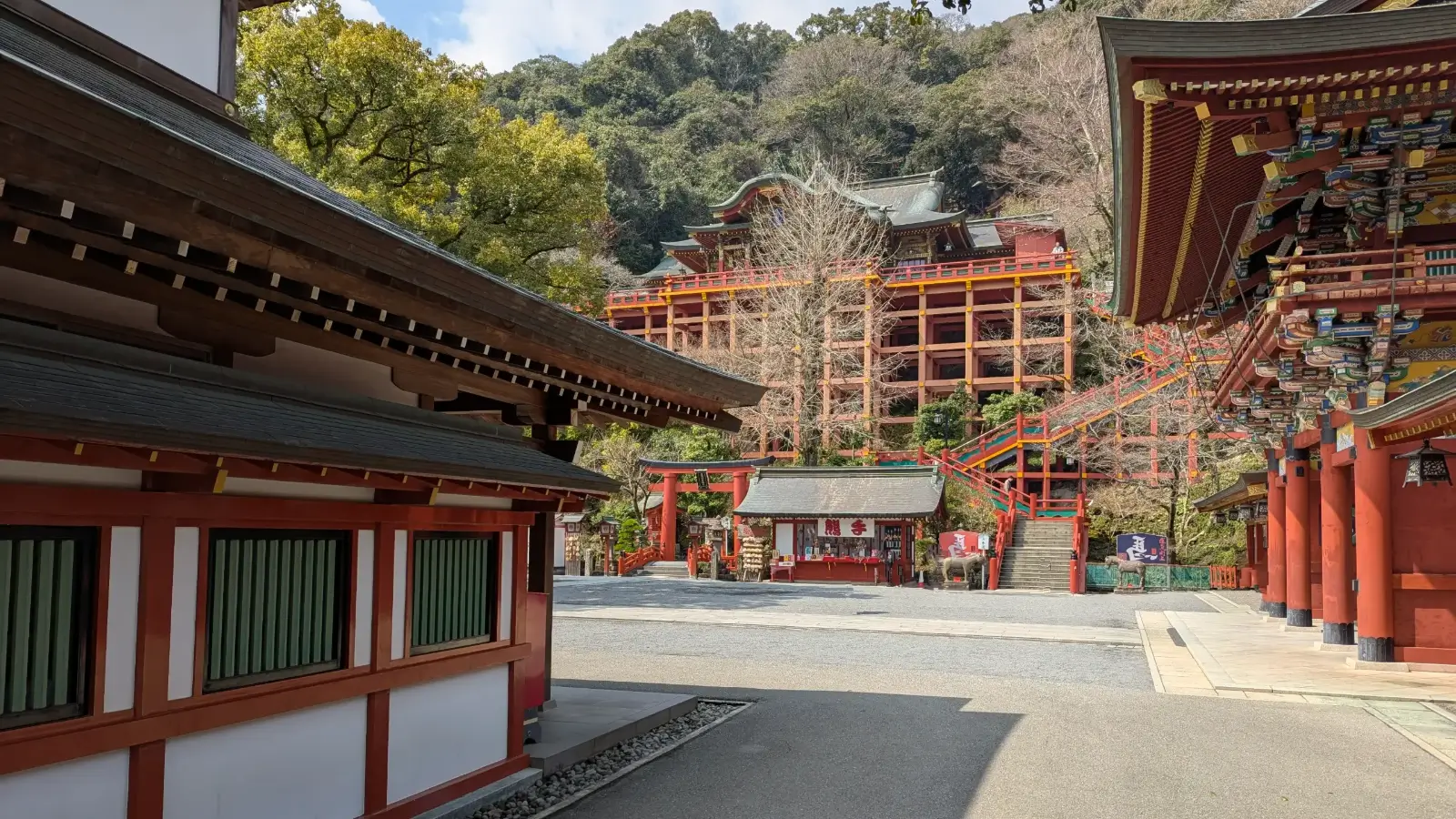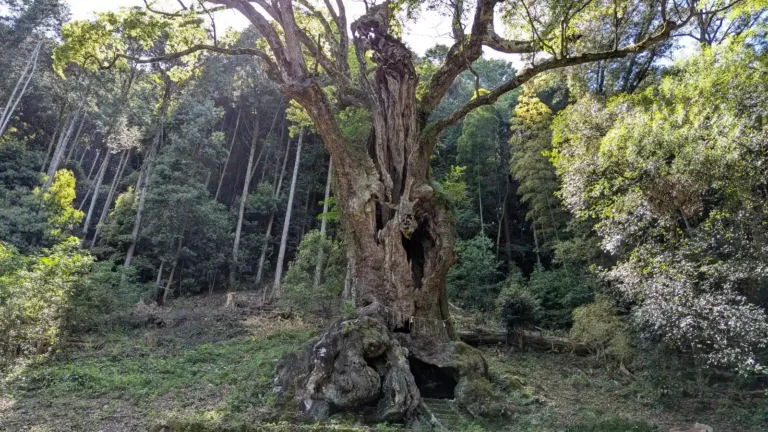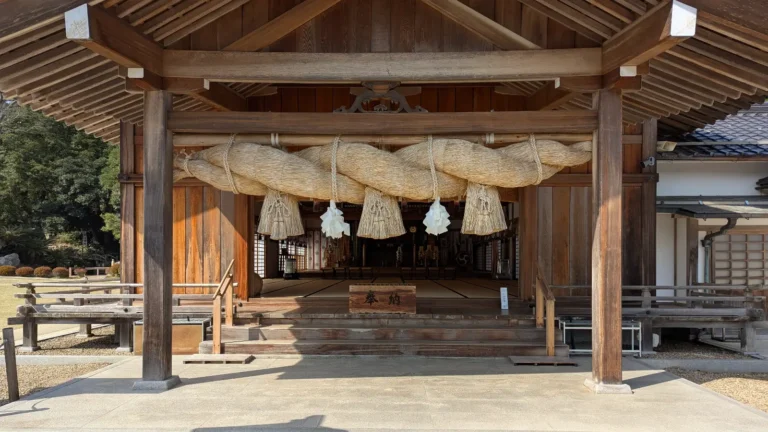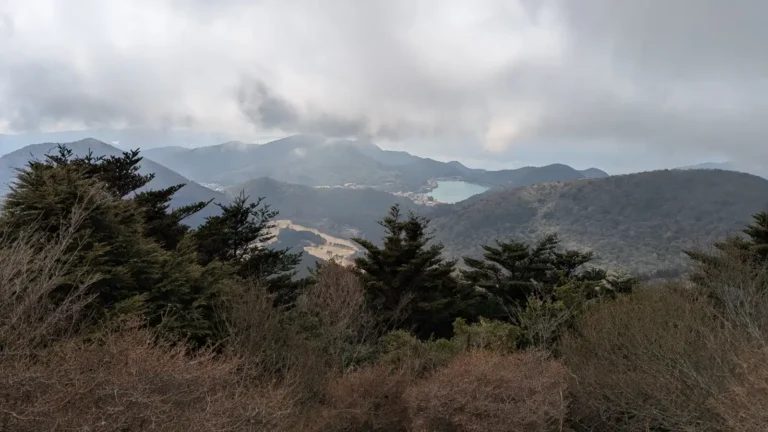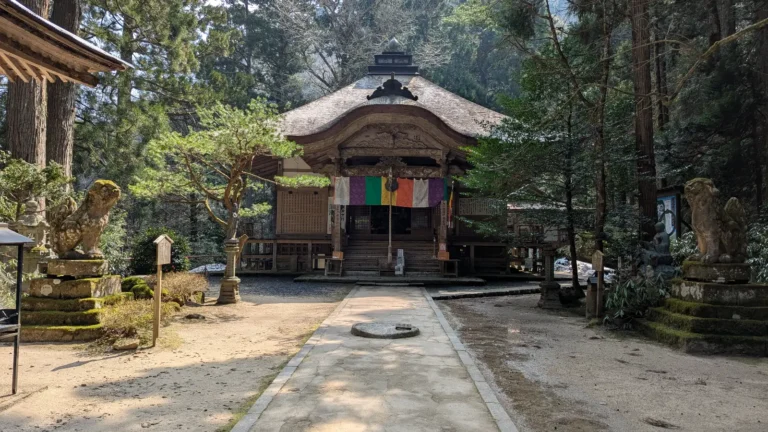Yutoku Inari Shrine: A JOTM Guide
Tucked into the forested hills of southern Saga, Yutoku Inari Shrine (祐徳稲荷神社) rises on red stilts from the slope of a sacred mountain. Its vermilion halls, suspended between sky and stone, hum with quiet power. Built in 1687 and still largely off the tourist path, this is one of Japan’s most atmospheric Inari shrines, where foxes stand watch and mist guides the way.
Select links in this guide are affiliate links. They help sustain this space… allowing us to share more, with less dependence on advertising.
*Prices are subject to change.
Yutoku Inari Shrine at a Glance: Shrine Overview & Quick Facts
- Region: Kyushu (Saga Prefecture)
- Nearest City: Kashima
- Type of Site: Shinto Shrine (Inari)
- Best Season to Visit:
- Spring (March–April): Sakura along the stone lantern path
- Autumn (November): Vibrant fall foliage in the mountain trail
- Winter (January–February): Occasional snow and quiet atmosphere
Why It’s Special in One Sentence
Yutoku Inari Shrine rises from the forest like a dream half-remembered, its red pillars winding skyward, asking travelers to follow.
Why Yutoku Inari Shrine Is Worth Discovering: Highlights of Yutoku Inari’s Sacred Atmosphere and Symbolism
- Perched on a dramatic hillside platform, the main worship hall feels suspended in the air, connected more to wind and trees than to earth.
- Dozens of torii gates create a sacred tunnel through the forest, each one a vow, a wish, or a remembrance offered to Inari.
- As one of Japan’s most important Inari shrines, fox statues are everywhere, messengers of the deity, guardians of mystery.
- Founded in 1687 by the Nabeshima clan, the shrine is layered with centuries of reverence, each stone stair worn down by devotion.
- The deeper you go, the quieter it becomes. The upper shrine trail leads through forest to a panoramic overlook, a reward earned, not given.
- Ceremonies, omikuji fortunes, and ema plaques keep the sacred alive. Locals still come here to ask for abundance, guidance, and peace.
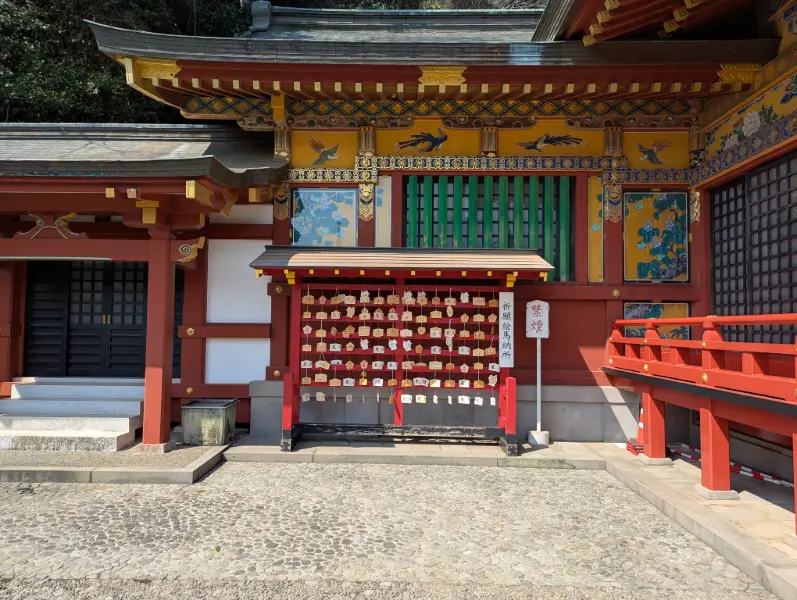
Must-See Wonders at Yutoku Inari Shrine: Hall, Tunnel, and Forest Highlights
Main Worship Hall (Honden)
- Built on stilts into the hillside, the vivid red hall floats over the valley like a stage between realms.
- Stand at the edge and watch clouds shift through the forest, it feels like the mountain is breathing.
Torii Tunnel and Forest Trail
- Behind the main hall, a narrow path snakes upward through a tunnel of torii gates.
- Each step is a small ritual, each gate a gentle boundary crossed between self and spirit.
Upper Shrine Lookout
- The climb is steep and winding, but the view, over Kashima’s rooftops, across to the Ariake Sea, is pure stillness.
- Few travelers make it this far. That’s part of the invitation.
Kitsune Guardians
- Stone foxes flank nearly every corner, each with a key, scroll, or jewel in its mouth.
- Their gaze is playful and piercing, watching more than you know.
Sacred Spring & Garden
- Near the base, a small water feature and garden offer rest and reflection.
- In summer, the air here is thick with green and birdsong.
Local Secrets from JOTM: Hidden Tips for Visiting Yutoku Inari Shrine
- Climb Before the Crowds: Arrive just after sunrise to walk the torii tunnel in solitude, each footstep your own offering.
- Step Beyond the Main Hall: Many visitors stop at the platform. Keep going. The real spirit of Yutoku lives in the upper trail and forest quiet.
- Pause at the Lookout, Don’t Rush: Bring tea or a snack and sit at the top. This isn’t just a view, it’s a conversation between wind, memory, and sky.
- Come in Winter for Stillness: When the trees are bare and the air is clear, the shrine feels older, more intimate, more eternal.
- Write with Intention: If you hang an ema plaque, take your time. The act itself is the prayer.
Nearby Sacred Spaces: Shrines, Gardens, and Historic Towns Near Yutoku Inari Shrine You Shouldn’t Miss
- Takeo Onsen – A place to warm your bones after the climb, surrounded by forest and tradition (40 minutes by train).
- Mifuneyama Rakuen – A stunning seasonal garden sculpted into a mountainside, especially magical in spring and autumn (45 minutes by train).
- Hizen Hamashuku – Old white-walled storehouses and quiet alleys perfect for strolling and sipping (15 minutes by taxi).
Getting to Yutoku Inari Shrine: How to Access the Shrine by Foot, Bus, or Train
- By Train: Take the JR Nagasaki Line to Hizen-Kashima Station. From there, it’s a 10-minute taxi ride or local bus to the shrine.
- By Bus: From Hizen-Kashima Station, take the Yutoku Bus to “Yutoku Jinja-mae” stop (approx. 10 minutes). The shrine entrance is just ahead.
- By Foot: A scenic 30-minute walk from the station through town and countryside. Best in spring or autumn.
- Hours: Always accessible
- Cost: Free entry; donations welcome for rituals and ema plaques.
For travelers using the Japan Rail Pass, portions of this route may be covered, our guide offers practical insights on when it’s worth considering.
Resting Nearby: Hotels near Yutoku Inari Shrine
- Taishoya (Ureshino Onsen) – Upscale onsen retreat with seasonal kaiseki and garden-view baths
- Wataya Besso (Ureshino Onsen) – Elegant resort with riverside hot springs and modern comfort
- Ureshino Yadoya – A boutique hideaway known for its minimalist design and rich tea culture, set within Ureshino’s serene onsen district.
- Hotel Sakura Ureshino – Traditional charm meets comfort in this hot spring hotel, where soft waters and seasonal cuisine invite you to linger longer.
- Akanesasu Hizenhamashuku – Nestled in a preserved sake town, this small inn offers atmospheric lodging amid white-walled storehouses and historic quiet.
If you’re planning a broader journey through Japan, our foundational guides offer clarity for every step of the way. Explore Planning a Trip to Japan: A JOTM Guide, learn How to Get Around Japan, and find the Best Time to Visit Japan for a season that resonates with your rhythm.
FAQs and Travel Tips about Yutoku Inari Shrine: A Few Last Things Before You Go
Planning your visit to Yutoku Inari Shrine? These travel tips and frequently asked questions will help you navigate this sacred Saga destination with ease.
A: The shrine is most beautiful in spring (late March–early April) during cherry blossom season, and in autumn (late October–mid-November) when vivid foliage lines the hillside paths. Early mornings in these seasons offer the quietest, most atmospheric experience.
A: Most visitors spend 1.5 to 2 hours here, enough time to explore the main hall, climb through the torii trail, and reach the upper shrine lookout for panoramic views across Saga.
A: Yutoku Inari Shrine is in Kashima City, Saga Prefecture, on the western side of Kyushu island. It’s about a 10-minute bus or taxi ride from Hizen-Kashima Station on the JR Nagasaki Line.
A: Yutoku Inari Shrine is one of Japan’s top three Inari shrines, known for its striking hillside construction, long rows of torii gates, and its deep connection to the fox deity Inari, associated with prosperity and protection.
A: Entry to Yutoku Inari Shrine is free and does not require tickets. Ritual offerings, omamori charms, and ema plaques can be purchased in person. Special event reservations are handled on-site.
A: The lower shrine area, including the main hall and shopping street, is accessible via paved paths. However, the forest trail and upper shrine involve steep stairs and uneven ground, which may not be suitable for those with mobility challenges.
A: Foxes (kitsune) are sacred messengers of the deity Inari, who is worshipped for blessings in agriculture, prosperity, and protection. Their presence at the shrine symbolizes guidance, transformation, and the unseen forces that shape daily life.
A: Yes. The most important is the Hatsuuma Festival in early February, which celebrates Inari with rituals, processions, and prayers for prosperity. Seasonal flower events and New Year’s celebrations also draw visitors throughout the year.
A: From Fukuoka, take the JR Limited Express to Hizen-Kashima Station (about 1.5 hours), then a 10-minute taxi or local bus to the shrine. From Nagasaki, it’s about 1 hour by train on the JR Nagasaki Line.
A: Yes, the shrine is open daily throughout the year. Manned hours typically run from 9:00 AM to 5:00 PM, with extended access during festivals and New Year visits.

